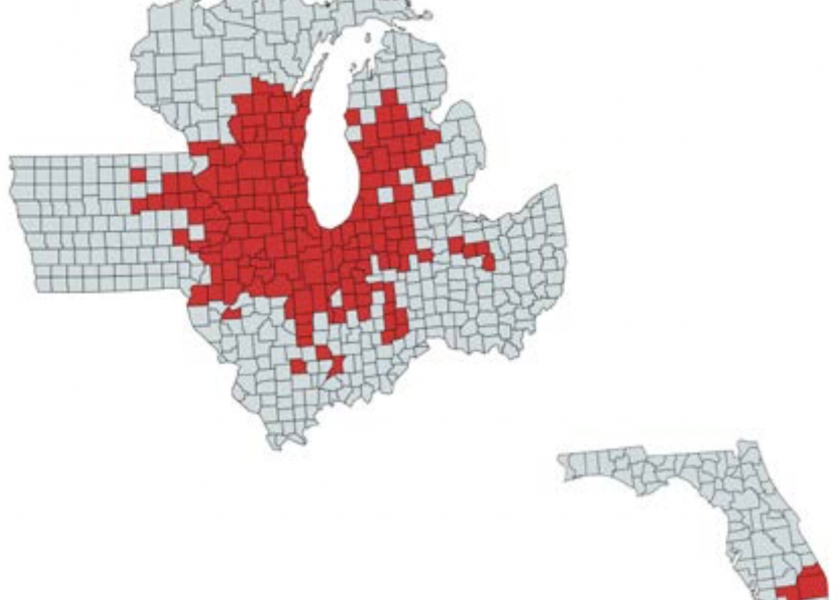“New” Corn and Soybean Diseases Present Seed Selection Challenges

Wet weather brought a myriad of problems in 2019. Aside from planting and harvest delays, it helped spread diseases, many of which could show up again in 2020.
If you haven’t made your seed decision, or have flexibility in where you place genetics, use 2019’s disease history to optimize seed placement. Consider in-plant resistances or vulnerability to certain diseases because many overwinter in crop residue.
Tar spot has experts most concerned for corn in 2020.
Tar spot entered the U.S. in 2015 from Central America. According to Bayer research, it can reduce Midwest corn yields by up to 40 bu. per acre. The challenge with new diseases is seed and chemical companies have to identify genetics or chemicals that protect crops. No matter what, it never seems fast enough.
“With these new diseases we might not have the comfort level we’d like with genetic tolerances,” says Brian Norton, Syngenta agronomy service representative. “Or, maybe, it’s that a corn or soybean hybrid or variety that typically does well in my environment doesn’t have the disease rating I’m looking for.”
Some hybrids might have natural tolerances against tar spot but seed companies haven’t had to test for it in the past, which means they don’t have definitive data to prove it.
Use these tips from the Crop Protection Network, a consortium of disease experts to manage tar spot:
-
Manage residue. Tar spot overwinters in residue. Consider burying it with tillage to encourage decomposition and reduce inoculum.
-
Rotate crops. This allows residue to decompose without a host to reduce inoculum. Researchers don’t know how many years it takes yet to sufficiently reduce inoculum.
-
Avoid highly susceptible hybrids. If known, look for at least moderate tolerance.
-
Consider fungicides. Some fungicides can reduce tar spot and several have received 2ee labels that can be used to manage the disease.
Midwest soybean growers: Have you heard of target spot?
Farmers in the Delta and Southeast are all too familiar with a disease that’s only recently been a threat in the Midwest: Target spot. For growers who’ve had the disease in the past, it’s become “when” not “if” it shows up, according to BASF.
This past year acted like a greenhouse for this damaging soybean disease. Target spot thrives in humid, moist conditions, which makes southern states prime for the disease.
“Soybean losses of up to 50% have been reported,” says Dan Mitchell, LG Seeds technical team agronomist. “Yield losses are a result of lost leaf canopy which, in turn, reduces yield capability of a crop.”
However, in recent fungicide efficacy trials, Mississippi State University Extension Plant Pathologist Tom Allen says he's documented a six to 10 bu. per acre decrease when target spot was severe. One reason he says losses can appear inflated is that pod and stem blight can produce symptoms that look similar to target spot. Both have lower canopy defoliation and prefer a similar disease environment, serving to add further confusion.
You can find soybeans with genetic tolerance to target spot—especially southern growers or farmers who can plant southern cultivars. As it moves north, there will likely be a learning curve and a little time before those genetics are identified, much like tar spot resistance in corn.
If you’re among the growers who are new to the disease, University of Tennessee Extension recommends the following to control target spot:
-
Rotate to a non-host, such as corn.
-
Plant multiple, stable varieties.
-
Consider fungicide applications.
New diseases can be intimidating—but don’t let them get the best of you. Do your research, talk with local agronomists and identify your risk. Once you know, take action and kick 2020 off the right way.
Prepare for familiar foes that might overwinter in fields.
Certain diseases are always lurking thanks to overwintering in crop residue. Keep an eye out for risk of gray leaf spot, northern corn leaf blight, frogeye leaf spot and Phytophthora.
Gray leaf spot is common in Corn Belt states and can steal up to 40 bu. per acre, according to research from Bayer. This disease thrives in warm, wet conditions and high humidity. If it was in fields in 2019, look for in-seed resistance in 2020. In addition, tillage and crop rotation can help break up the disease.
Northern corn leaf blight favors wet and humid weather. It is more common in northern corn growing states and can reduce yields by 50% of potential. This disease overwinters in crop residue, so it’s important to keep good records and look for seeds with genetic resistance. Fungicides can also help in-season and breaking up the inoculum by tillage or switching crops can effectively reduce your risk, too.
“With a lot of wet conditions this year, farmers are looking for varieties with good tolerance to diseases like frogeye leaf spot and Phytophthora,” says Andy Robinson, Mycogen Seeds agronomist.
Frogeye leaf spot can decrease yields up to 30%, according to University of Nebraska Extension. It infects the plant through infested residue, infected seed or airborne spores. Consider seed with genetic resistance, tillage and chemical or biological control to avoid yield loss.
Fortunately, there are many varieties with tolerances to Phytophthora, in addition to seed treatments that target the disease. The disease can live in the soil for up to 10 years and soybeans are the only known host for this pathogen. University of Minnesota Extension experts recommend reducing saturated soils to decrease the risk of the disease, such as tiling fields. In addition, look for resistant varieties, rotate crops, use seed treatment and consider tillage in fields with a history of the pathogen.







